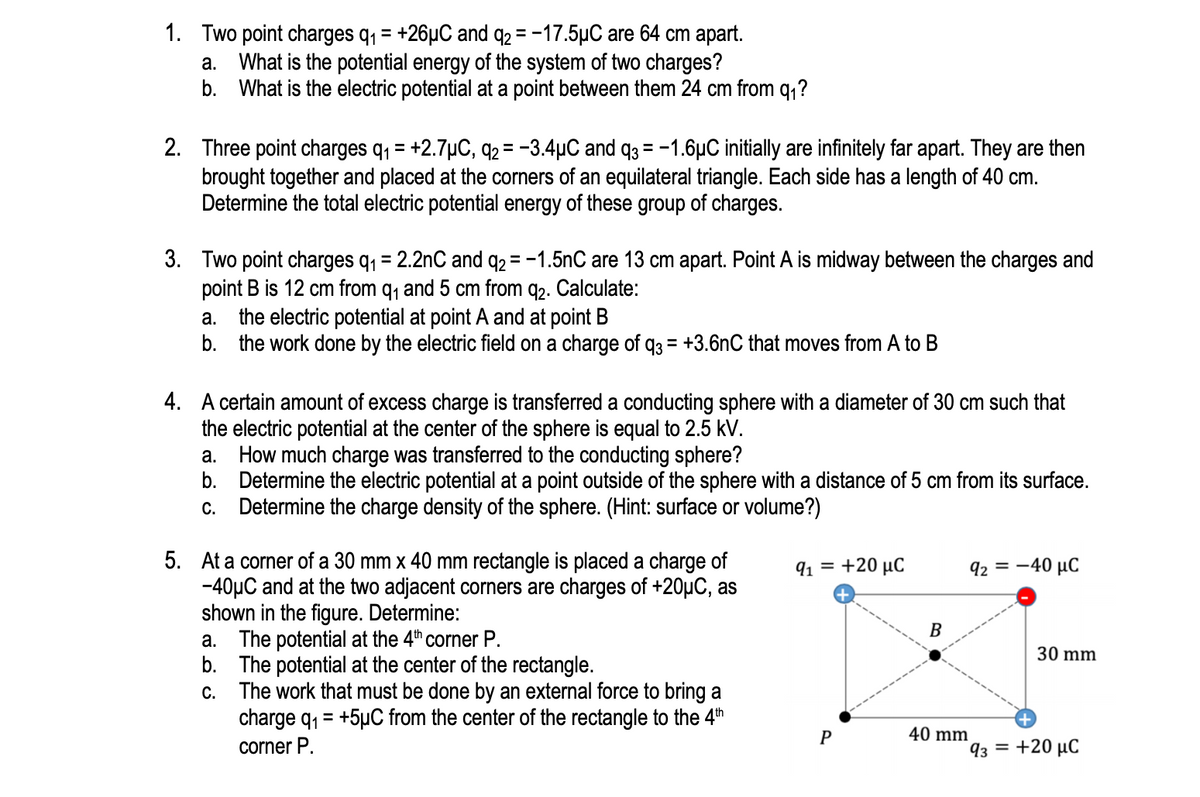1. Two point charges q, = +26µC and q2 = -17.5µC are 64 cm apart. a. What is the potential energy of the system of two charges? b. What is the electric potential at a point between them 24 cm from q,?
1. Two point charges q, = +26µC and q2 = -17.5µC are 64 cm apart. a. What is the potential energy of the system of two charges? b. What is the electric potential at a point between them 24 cm from q,?
College Physics
10th Edition
ISBN:9781285737027
Author:Raymond A. Serway, Chris Vuille
Publisher:Raymond A. Serway, Chris Vuille
Chapter16: Electrical Energy And Capacitance
Section: Chapter Questions
Problem 18P: A positive point charge q = +2.50 nC is located at x = 1.20 m and a negative charge of 2q = 5.00 nC...
Related questions
Question

Transcribed Image Text:1. Two point charges q, = +26µC and q2 = -17.5µC are 64 cm apart.
a. What is the potential energy of the system of two charges?
b. What is the electric potential at a point between them 24 cm from q,?
2. Three point charges q, = +2.7µC, q2 = -3.4µC and q3 = -1.6µC initially are infinitely far apart. They are then
brought together and placed at the corners of an equilateral triangle. Each side has a length of 40 cm.
Determine the total electric potential energy of these group of charges.
3. Two point charges q, = 2.2nC and q2= -1.5nC are 13 cm apart. Point A is midway between the charges and
point B is 12 cm from q, and 5 cm from q2. Calculate:
a. the electric potential at point A and at point B
b. the work done by the electric field on a charge of q3 = +3.6nC that moves from A to B
4. A certain amount of excess charge is transferred a conducting sphere with a diameter of 30 cm such that
the electric potential at the center of the sphere is equal to 2.5 kV.
a. How much charge was transferred to the conducting sphere?
b. Determine the electric potential at a point outside of the sphere with a distance of 5 cm from its surface.
c. Determine the charge density of the sphere. (Hint: surface or volume?)
5. At a corner of a 30 mm x 40 mm rectangle is placed a charge of
-40µC and at the two adjacent corners are charges of +20µC, as
shown in the figure. Determine:
a. The potential at the 4th corner P.
b. The potential at the center of the rectangle.
The work that must be done by an external force to bring a
charge q, = +5µC from the center of the rectangle to the 4th
91 = +20 µC
92 = -40 µC
B
30 mm
С.
40 mm
corner P.
93 = +20 µC
Expert Solution
This question has been solved!
Explore an expertly crafted, step-by-step solution for a thorough understanding of key concepts.
This is a popular solution!
Trending now
This is a popular solution!
Step by step
Solved in 2 steps with 2 images

Knowledge Booster
Learn more about
Need a deep-dive on the concept behind this application? Look no further. Learn more about this topic, physics and related others by exploring similar questions and additional content below.Recommended textbooks for you

College Physics
Physics
ISBN:
9781285737027
Author:
Raymond A. Serway, Chris Vuille
Publisher:
Cengage Learning

College Physics
Physics
ISBN:
9781305952300
Author:
Raymond A. Serway, Chris Vuille
Publisher:
Cengage Learning

Physics for Scientists and Engineers, Technology …
Physics
ISBN:
9781305116399
Author:
Raymond A. Serway, John W. Jewett
Publisher:
Cengage Learning

College Physics
Physics
ISBN:
9781285737027
Author:
Raymond A. Serway, Chris Vuille
Publisher:
Cengage Learning

College Physics
Physics
ISBN:
9781305952300
Author:
Raymond A. Serway, Chris Vuille
Publisher:
Cengage Learning

Physics for Scientists and Engineers, Technology …
Physics
ISBN:
9781305116399
Author:
Raymond A. Serway, John W. Jewett
Publisher:
Cengage Learning

Principles of Physics: A Calculus-Based Text
Physics
ISBN:
9781133104261
Author:
Raymond A. Serway, John W. Jewett
Publisher:
Cengage Learning

Physics for Scientists and Engineers
Physics
ISBN:
9781337553278
Author:
Raymond A. Serway, John W. Jewett
Publisher:
Cengage Learning

Physics for Scientists and Engineers with Modern …
Physics
ISBN:
9781337553292
Author:
Raymond A. Serway, John W. Jewett
Publisher:
Cengage Learning